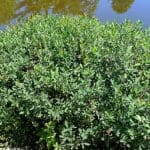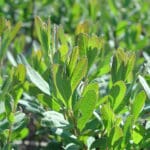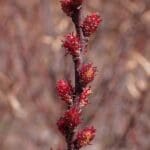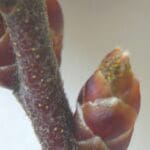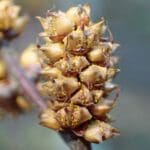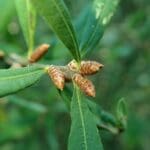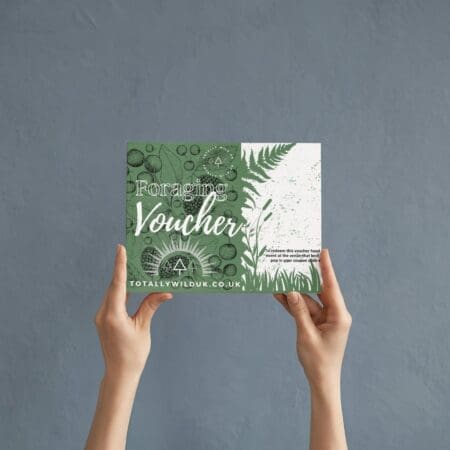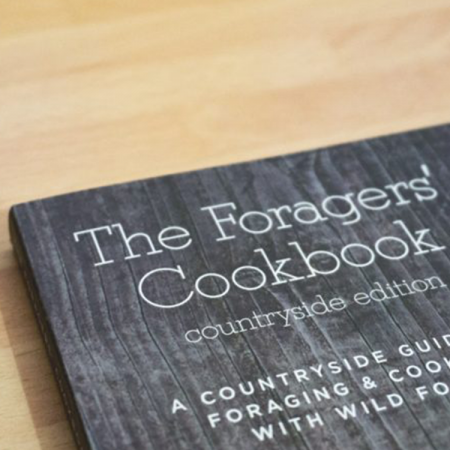Bog Myrtle/ Spring / Summer / Autumn / Edible
Bog myrtle thrives in acidic boggy conditions, as the name might suggest.. It is found throughout the Northern hemisphere, From Eurasia and Japan to North America.
Common Names
Sweet gale, Candleberry, Moor myrtle,
Botanical Name
Myrica gale
Scientific Classification
Kingdom – Plantae
Order –Fagales
Family – Myricaceae
Physical Characteristics for Bog Myrtle
Leaves
The small deciduous leaves are elongated oval in shape, up to 6 cm long and tapering towards the base. They are borne on multiple twiggy stems up to 1.5 metres tall. The whole bush resembles a small stunted Willow, all the more bushy if grazing deer have stunted its height and caused it to throw out more side branches. The shiny brown to orange buds look like a tiny, very neat pine cone.
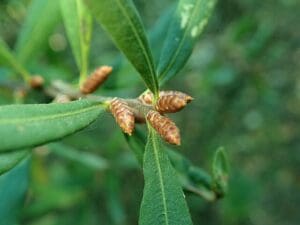
Flowers
The small catkins appear just before the leaves in Spring, usually on separate male and female plants but sometimes both on one individual. The male catkins are yellowy-brown, emerging from orange buds, while the female flowers have red tufts.
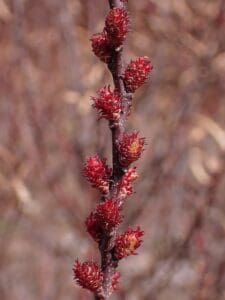
Seeds
Small, knobbly, brownish yellow fruits form from the female flowers, in late summer. Like the leaves, these have glands that produce scented oils. The small seeds are easily dispersed in water, allowing the plant to spread around wet landscapes.
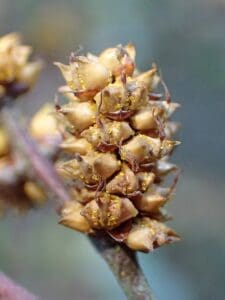
Roots
The rhizomes store energy and host nitrogen fixing bacteria. These help them cope with nutrient poor environments. The plant can reproduce by suckering from these spreading rhizomes as well as by seed.
Habitat
Bog Myrtle is well adapted to bogs with acidic soil. and can also thrive in some coastal habitats such as estuaries.
Known Hazards
The plant is a known abortifacient, so should not be consumed by anyone who wants to get or stay pregnant. The oils, though used to heal the skin, can also cause skin irritation in some people and should not be applied neat as an essential oil.
Could be Confused with
It would be very easy to confuse with a young willow or sallow tree – check the precise leaf, bud and flower shapes to see the subtle differences. The whorls of leaves also bear a slight resemblance to ornamental garden euphorbia varieties, though these typically don’t have woody stems and exude a milky sap when damaged.
Edible Uses
The fruits and leaves can be used as a herbal tea and as a seasoning. They were also widely used to flavour beers in Europe, before Hops became more fashionable
Notes on Herbal Uses
The sweet resinous scent works as an insect repellant, and can be used as an ingredient in antiseptic wound and acne treatments (here’s a nice recipe in a healing balm (https://frontierbushcraft.com/2017/07/27/bog-myrtle-balm/ ) It is also used in perfumery. In what is now Eastern Canada, it was used in traditional medicine for stomach, liver and bronchial problems. The Vikings were said to use it to treat memory problems and low mood.
Conservation Considerations
The shrub supports many different insect species, which in turn provide food for other creatures up the food web. Much as Bog Myrtle itself isn’t badly endangered, The habitats you might still find it in can potentially be quite rare and sensitive – you should try not to cause too much disturbance on mossland for example. Do not go picking on SSSIs , just appreciate the unique ecology and do your bit to preserve it.
Extra notes from the Foragers
A British Royal tradition was started when Queen Victoria planted a Bog myrtle on the Isle of Wight, which was itself a gift from Prince Alberts grandmother. Her daughter (also named Victoria) used sprigs from that bush in her wedding bouquet, and so have Royal brides ever since.



